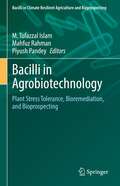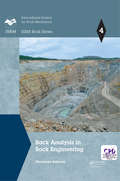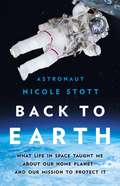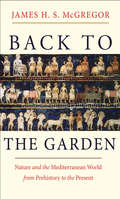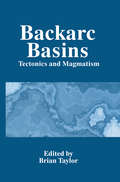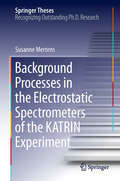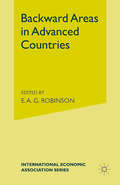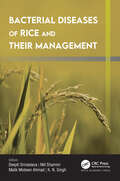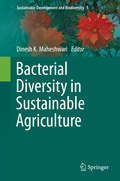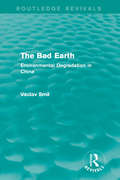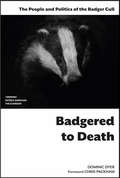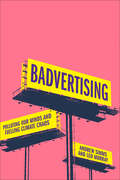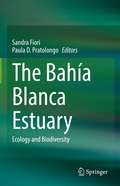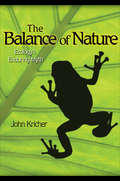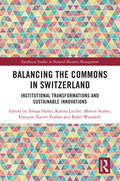- Table View
- List View
Bacilli in Agrobiotechnology: Plant Stress Tolerance, Bioremediation, and Bioprospecting (Bacilli in Climate Resilient Agriculture and Bioprospecting)
by M. Tofazzal Islam Mahfuz Rahman Piyush PandeyThe third volume of the series ‘Bacilli and Agrobiotechnology’ is comprised of 25 chapters that bring a unique perspective to the readers about Bacillus-mediated biotic and abiotic plant stress tolerance, bioremediation and bioprospecting. These chapters are prepared by the leading scientists of global repute. The negative impacts of agrochemicals such as chemical fertilizers and pesticides on human health and environment are paramount. Bacillus and allied genera of beneficial plant-associated microbes are presenting beacon of hope to the farmers, plant scientists and stewards of environment. Several chapters of this volume focus on the induction of various signaling pathways in plants by Bacillus spp. to alleviate biotic and abiotic stresses impacted by global climate change Agricultural lands contaminated with heavy metals affect the ecological food chain starting from crop cultivation. How the toxic effects of trace metals originating from industrial effluents and agrochemicals can be remediated? This book addresses how to overcome these issues by applying elite strains of Bacillus. Bioprospecting is a systematic and organized search for conversion of bioresources to industrially important products by utilizing microbe-derived metabolites. This volume is enriched by including the bioprospecting aspects mediated by Bacillus spp. with novel insights.
Back Analysis in Rock Engineering (ISRM Book Series)
by Shunsuke SakuraiThis book provides practicing engineers working in the field of design, construction and monitoring of rock structures such as tunnels and slopes with technical information on how to design, how to excavate and how to monitor the structures during their construction. Based on the long-term engineering experiences of the author, field measurements together with back analyses are presented as the most powerful tools in rock engineering practice. One of the purposes of field measurements is to assess the stability of the rock structures during their construction. However, field measurement results are only numbers unless they are quantitatively interpreted, a process in which back analyses play an important role. The author has developed both the concepts of “critical strain” and of the “anisotropic parameter” of rocks, which can make it possible not only to assess the stability of the structures during their construction, but also to verify the validity of design parameters by the back analysis of field measurement results during the constructions. Based on the back analysis results, the design parameters used at a design stage could be modified if necessary. This procedure is called an “Observational method”, a concept that is entirely different from that of other structures such as bridges and buildings. It is noted that in general, technical books written for practicing engineers mainly focus on empirical approaches which are based on engineers’ experiences. In this book, however, no empirical approaches will be described, instead, all the approaches are based on simple rock mechanics theory. This book is the first to describe an observational method in rock engineering practice, which implies that the potential readers of this book must be practicing engineers working on rock engineering projects.
Back Analysis in Rock Engineering (ISRM Book Series)
by Shunsuke SakuraiThis book provides practicing engineers working in the field of design, construction and monitoring of rock structures such as tunnels and slopes with technical information on how to design, how to excavate and how to monitor the structures during their construction. Based on the long-term engineering experiences of the author, field measurements together with back analyses are presented as the most powerful tools in rock engineering practice. One of the purposes of field measurements is to assess the stability of the rock structures during their construction. However, field measurement results are only numbers unless they are quantitatively interpreted, a process in which back analyses play an important role. The author has developed both the concepts of “critical strain” and of the “anisotropic parameter” of rocks, which can make it possible not only to assess the stability of the structures during their construction, but also to verify the validity of design parameters by the back analysis of field measurement results during the constructions. Based on the back analysis results, the design parameters used at a design stage could be modified if necessary. This procedure is called an “Observational method”, a concept that is entirely different from that of other structures such as bridges and buildings. It is noted that in general, technical books written for practicing engineers mainly focus on empirical approaches which are based on engineers’ experiences. In this book, however, no empirical approaches will be described, instead, all the approaches are based on simple rock mechanics theory. This book is the first to describe an observational method in rock engineering practice, which implies that the potential readers of this book must be practicing engineers working on rock engineering projects.
Back to Earth: What Life in Space Taught Me About Our Home Planet—And Our Mission to Protect It
by Nicole StottInspired by insights gained in spaceflight, a NASA astronaut offers key lessons to empower Earthbound readers to fight climate changeWhen Nicole Stott first saw Earth from space, she realized how interconnected we are and knew she had to help protect our planetary home.In Back to Earth, Stott imparts essential lessons in problem-solving, survival, and crisis response that each of us can practice to make change. She knows we can overcome differences to address global issues, because she saw this every day on the International Space Station. Stott shares stories from her spaceflight and insights from scientists, activists, and changemakers working to solve our greatest environmental challenges. She learns about the complexities of Earth&’s biodiversity from NASA engineers working to enable life in space and from scientists protecting life on Earth for future generations. Ultimately, Stott reveals how we each have the power to respect our planetary home and one another by living our lives like crewmates, not passengers, on an inspiring shared mission
Back to the Garden: Nature and the Mediterranean World from Prehistory to the Present
by James H. McGregorThe garden was the cultural foundation of the early Mediterranean peoples; they acknowledged their reliance on and kinship to the land, and they understood nature through the lens of their diversely cultivated landscape. Their image of the garden underwrote the biblical book of Genesis and the region’s three major religions. In this important melding of cultural and ecological histories, James H. S. McGregor suggests that the environmental crisis the world faces today is a result of Western society’s abandonment of the “First Nature” principle--of the harmonious interrelationship of human communities and the natural world. The author demonstrates how this relationship, which persisted for millennia, effectively came to an end in the late eighteenth century, when “nature” came to be equated with untamed landscape devoid of human intervention. McGregor’s essential work offers a new understanding of environmental accountability while proposing that recovering the original vision of ourselves, not as antagonists of nature but as cultivators of a biological world to which we innately belong, is possible through proven techniques of the past.
Backarc Basins: Tectonics and Magmatism
by Brian TaylorExperts in the field offer the first comprehensive review of the tectonics and magmatism of backarc basins, covering their initial rift stage to mature spreading. Complete with numerous illustrations, each of the twelve chapters focuses on a young, active backarc basin of the circum-Pacific-where volcano-tectonic processes are best studied because of their activity. Key themes in this volume include volcano-tectonics setting; cause and location; rift magmas; and hydrothermal activity. Researchers also present models of the dynamic processes occurring in backarc basins.
Background Processes in the Electrostatic Spectrometers of the KATRIN Experiment (Springer Theses)
by Susanne MertensNeutrinos continue to be the most mysterious and, arguably, the most fascinating particles of the Standard Model as their intrinsic properties such as absolute mass scale and CP properties are unknown. The open question of the absolute neutrino mass scale will be addressed with unprecedented accuracy by the Karlsruhe Tritium Neutrino (KATRIN) experiment, currently under construction. This thesis focusses on the spectrometer part of KATRIN and background processes therein. Various background sources such as small Penning traps, as well as nuclear decays from single radon atoms are fully characterized here for the first time. Most importantly, however, it was possible to reduce the background in the spectrometer by more than five orders of magnitude by eliminating Penning traps and by developing a completely new background reduction method by stochastically heating trapped electrons using electron cyclotron resonance (ECR). The work beautifully demonstrates that the obstacles and challenges in measuring the absolute mass scale of neutrinos can be met successfully if novel experimental tools (ECR) and novel computing methods (KASSIOPEIA) are combined to allow almost background-free tritium ß-spectroscopy.
Backward Areas in Advanced Countries: (pdf) (International Economic Association Series)
by E. RobinsonBacterial Diseases of Rice and Their Management (Innovations in Agricultural & Biological Engineering)
by Deepti Srivastava Md. Shamim Malik Mobeen Ahmad K. N. SinghRice is a major staple food and a source of nutrition for over 3.5 billion people worldwide. It is, however, susceptible to a number of bacterial diseases that decrease its yield and quality. This book covers the bacterial diseases of rice and their management, focusing on sustainable management methods that involve biological control, conventional breeding, and molecular methods. It covers the biology of rice bacterial blight pathogens, virulence determinants, and host defense factors of bacterial blight pathogen-rice interactions. Different resistance rice cultivars, their resistance loci, and quantitative trait loci mapping in the important rice cultivars are also discussed. The book presents biological studies of the major rice bacterial diseases (rice bacterial brown stripe disease, bacterial leaf streak disease, rice bacterial panicle blight disease, rice bacterial foot rot, sheath brown rot disease) and presents comparative analyses of conventional breeding, and molecular management approaches, along with examples.
Bacterial Diseases of Rice and Their Management (Innovations in Agricultural & Biological Engineering)
Rice is a major staple food and a source of nutrition for over 3.5 billion people worldwide. It is, however, susceptible to a number of bacterial diseases that decrease its yield and quality. This book covers the bacterial diseases of rice and their management, focusing on sustainable management methods that involve biological control, conventional breeding, and molecular methods. It covers the biology of rice bacterial blight pathogens, virulence determinants, and host defense factors of bacterial blight pathogen-rice interactions. Different resistance rice cultivars, their resistance loci, and quantitative trait loci mapping in the important rice cultivars are also discussed. The book presents biological studies of the major rice bacterial diseases (rice bacterial brown stripe disease, bacterial leaf streak disease, rice bacterial panicle blight disease, rice bacterial foot rot, sheath brown rot disease) and presents comparative analyses of conventional breeding, and molecular management approaches, along with examples.
Bacterial Diversity in Sustainable Agriculture (Sustainable Development and Biodiversity #1)
by Dinesh K. MaheshwariThe earth’s biodiversity is a degree of ecosystem health which is vital to ecology and environmental sustainability. The microbial world is the largest unexplored reservoir. The agro-ecosystem enriched with rhizosphere implicit abundant and species-rich component of microbial diversity. Its global exploration designs a worldwide framework for agricultural sustainability adjoining benefits in its conservation.Agricultural sustainability requires a major share from ecosystem management which is better paid by microbial diversity and conservation. Diversity of bacteria influences plant productivity providing nutrient convenience from soil instead altering per se community and diversity in the rhizosphere where they may influence mechanistic competent and antagonistic micro-flora. The potential species among the diversity are therefore, essential subjective to their maintenance for use around the globe. Microbial population in agro-ecosystem is influenced by stresses, reduce functionality as a component. It is therefore, important to explore secrets of planned strategy so as to unravel the microbial diversity and conservation in agricultural development. Microorganisms are minute, pervasive in nature and alleged as disease host instead tiny recognize as employee of agro-ecosystem, indulge in agricultural development and potential contributor in world of ecological and economical wealth creation. This step pertinently would help to launch scientific motivation needed to support the refrain of microbial diversity and conservation.
The Bad Earth: Environmental Degradation in China (Routledge Revivals)
by Vaclav SmilAs China strives to significantly increase its economic output, the nation faces an acute deterioration of the physical resources from which this prodigious growth springs. Major problems include water shortages, the pollution of water, high levels of carcinogens in the air, accelerating erosion, and industrial pollution. Originally published in 1984, Vaclav Smil documents and evaluates China’s environmental crisis. This title will be of particular interest for students of Environmental Studies and Development Studies.
The Bad Earth: Environmental Degradation in China (Routledge Revivals)
by Vaclav SmilAs China strives to significantly increase its economic output, the nation faces an acute deterioration of the physical resources from which this prodigious growth springs. Major problems include water shortages, the pollution of water, high levels of carcinogens in the air, accelerating erosion, and industrial pollution. Originally published in 1984, Vaclav Smil documents and evaluates China’s environmental crisis. This title will be of particular interest for students of Environmental Studies and Development Studies.
Badgered to Death: The People and Politics of the Badger Cull
by Dominic Dyer'A thriller, whodunnit and impassioned polemic' (Patrick Barkham, Guardian) Dominic Dyer explores the science and electioneering behind Britain's most controversial wildlife policy: the badger cull. He exposes the catastrophic handling of bovine TB by the UK government, the political manoeuvring that led to the cull being devised in 2010, and the ongoing close relationship between its two instigators in Britain — the National Farmers Union and the Department of the Environment, Food and Rural Affairs (DEFRA). He shines an unflattering spotlight on Cabinet ministers, the veterinary profession, environmental NGOs and the BBC, accusing them of doing too little to protect a protected wild species. Introduction by Chris Packham, naturalist and BBC TV presenter 'For many reasons we had come to love the badger, to cherish and admire it, to protect and celebrate it and of course many still do. 'But the reputation of this essential member of the UK's ecology has been targeted by a smear campaign which has been swallowed by the gullible and fuelled by those with vested interests.' (Chris Packham, Introduction) REVIEWS 'A thriller, whodunnit and impassioned polemic, this is the inside story of the badger cull. 'A vital must-read for anyone concerned about the badger's enduring place in the British countryside.' (Patrick Barkham, nature writer for The Guardian.) It should be read by all those battling against government policies that put money ahead of science and the environment.Our natural world is too important to be over-ridden in this way. Dyer... pays tribute to the 'Badger Army', those many individuals from all walks of life who turned out to protest and importantly, once culling started, to protect the badgers out in the field. Badgered to Death is for them because it tells them just why they must keep fighting the culls. It will convince any reader how very wrong and ineffective the culls will prove to be. (Lesley Docksey, The Ecologist) I enjoyed reading this book and I strongly recommend it to you. If you sign up to the main message of the book, that these culls are a waste of money, a waste of Badgers and at best a partial and inefficient way to reduce bovine TB then you will be hopping mad right now and reading this book won't calm you down, it will energise you. (Mark Avery, MarkAvery.info) A vital read for anyone cares about the future of British wildlife
The Badlands of Modernity: Heterotopia and Social Ordering (International Library of Sociology)
by Kevin HetheringtonThe Badlands of Modernity offers a wide ranging and original interpretation of modernity as it emerged during the eighteenth century through an analysis of some of the most important social spaces. Drawing on Foucault's analysis of heterotopia, or spaces of alternate ordering, the book argues that modernity originates through an interplay between ideas of utopia and heterotopia and heterotopic spatial practice. The Palais Royal during the French Revolution, the masonic lodge and in its relationship to civil society and the public sphere and the early factories of the Industrial Revolution are all seen as heterotopia in which modern social ordering is developed. Rather than seeing modernity as being defined by a social order, the book argues that we need to take account of the processes and the ambiguous spaces in which they emerge, if we are to understand the character of modern societies. The book uses these historical examples to analyse contemporary questions about modernity and postmodernity, the character of social order and the significance of marginal space in relation to issues of order, transgression and resistance. It will be important reading for sociologists, geographers and social historians as well as anyone who has an interest in modern societies.
The Badlands of Modernity: Heterotopia and Social Ordering (International Library of Sociology)
by Kevin HetheringtonThe Badlands of Modernity offers a wide ranging and original interpretation of modernity as it emerged during the eighteenth century through an analysis of some of the most important social spaces. Drawing on Foucault's analysis of heterotopia, or spaces of alternate ordering, the book argues that modernity originates through an interplay between ideas of utopia and heterotopia and heterotopic spatial practice. The Palais Royal during the French Revolution, the masonic lodge and in its relationship to civil society and the public sphere and the early factories of the Industrial Revolution are all seen as heterotopia in which modern social ordering is developed. Rather than seeing modernity as being defined by a social order, the book argues that we need to take account of the processes and the ambiguous spaces in which they emerge, if we are to understand the character of modern societies. The book uses these historical examples to analyse contemporary questions about modernity and postmodernity, the character of social order and the significance of marginal space in relation to issues of order, transgression and resistance. It will be important reading for sociologists, geographers and social historians as well as anyone who has an interest in modern societies.
Badvertising: Polluting Our Minds and Fuelling Climate Chaos
by Andrew Simms Leo Murray‘Why do we allow adverts that actively promote our own destruction? Halting climate catastrophe is hard enough without ads selling things that pollute more. With Badvertising, Simms and Murray have done the world an urgent favour. Funny and readable, it will make us all see advertising in a very different way’ Dr Chris van Tulleken, doctor, broadcaster and author of Ultra-Processed People‘Hugely timely and important … Grapples with advertising’s role in enabling climate crimes – and sets out why and how we need to stop the industry’s complicity in its tracks, for the sake of a liveable future’ Caroline Lucas MP‘Simms and Murray are clear-headed guides. Learn the history, be enraged at the tactics, and join the struggle for a less polluted public sphere’ Sam Knights, writer, actor and activist‘A much-needed book whose time has come. The continued advertising of high-carbon products at a time of climate crisis is a form of insanity. The authors are absolutely right’ Bill McGuire, Professor Emeritus of Earth Sciences, University College London‘This book was a watershed moment for me. Since it can’t have an advertising campaign, we all need to tell our friends about it’ Jeremy Vine, broadcaster and journalistAdvertising is selling us a dream, a lifestyle. It promises us fulfilment and tells us where to buy it – from international flights to a vast array of goods we consume like there is no tomorrow. The truth is, if advertising succeeds in keeping us on our current trajectory, there may not be a tomorrow.In Badvertising, Andrew Simms and Leo Murray raise the alarm on an industry that is making us both unhealthy and unhappy, and that is driving the planet to the precipice of environmental collapse in the process.What is the psychological impact of being barraged by literally thousands of advertisements a day? How does the commercialisation of our public spaces weaken our sense of belonging? How are car manufacturers, airlines and oil companies lobbying to weaken climate action? Examining the devastating impact of advertising on our minds and on the planet, Badvertising also crucially explores what we can do to change things for the better.Andrew Simms was called a ‘master at joined-up progressive thinking’ by New Scientist magazine. He co-authored the original Green New Deal, came up with Earth Overshoot Day, and jointly proposed the Fossil Fuel Non- Proliferation Treaty. He is the author of several books including Ecological Debt, Tescopoly, Cancel the Apocalypse and Economics: A Crash Course. He co-directs the New Weather Institute, is Assistant Director of Scientists for Global Responsibility, coordinates the Rapid Transition Alliance and is a Research Fellow at the University of Sussex.Leo Murray co-founded climate action charity Possible, where he is currently Director of Innovation, as well as noughties direct action pressure group Plane Stupid and pioneering solar rail enterprise Riding Sunbeams. Murray is also the creator of the Frequent Flyer Levy and the brains behind the Trump Baby blimp which rose to global fame during Donald Trump’s US presidency.
The Bahía Blanca Estuary: Ecology and Biodiversity
by Sandra M. Fiori Paula D. PratolongoThe Bahía Blanca Estuary is one of the largest coastal systems in Atlantic South America. This mesotidal estuary, situated in a sharp transition between humid subtropical and semiarid climates, has a unique combination of large interannual climatic variations. The estuarine area encompasses roughly 2300 square kilometers and is composed of wide expanses of intertidal flats, salt marshes, and emerged islands, which create intricate landscape patterns. Natural environments in the estuary sustain a high concentration of marine and terrestrial species, including endemic, threatened, and endangered fish and shorebirds. Puerto Cuatreros, in the inner zone of the estuary, hosts a permanent marine research station, whose records span more than 30 years of biophysical variables, and represent one of the largest time series of ecological data in South America. Beyond its ecological relevance, the Bahía Blanca Estuary is under increasing anthropogenic pressure from large urban settlements, industrial developments and harbors, raising the question of how to balance conservation and development. The Bahía Blanca Estuary: Ecology and Biodiversity offers a comprehensive review of life in the ecosystems of the estuary. The book is divided into five major sections, the first of which provides a description of the regional setting and covers key aspects of estuarine dynamics. The three following sections are dedicated to different habitat types and, within each section, the chapters are organized around major functional groups from pelagic and benthic environments. The fifth and final section covers issues related to management and conservation. Overall, the book provides essential and up-to-date reference material on the biodiversity and ecosystem processes of the Bahía Blanca Estuary, and will appeal to a broad international audience.
The Balance of Nature: Ecology's Enduring Myth
by John KricherThe idea of a balance of nature has been a dominant part of Western philosophy since before Aristotle, and it persists in the public imagination and even among some ecologists today. In this lively and thought-provoking book, John Kricher demonstrates that nature in fact is not in balance, nor has it ever been at any stage in Earth's history. He explains how and why this notion of a natural world in balance has endured for so long, and he shows why, in these times of extraordinary human influence on the planet's ecosystems, it is critical that we accept and understand that evolution is a fact of life, and that ecology is far more dynamic than we ever imagined. The Balance of Nature traces the fascinating history of the science of ecology and evolutionary biology, from the discipline's early innovators to the advent of Darwin and evolution, to the brilliant and inquisitive scientific minds of today. Blending insights and entertaining stories from his own remarkable life in science, Kricher reveals how evolution is a powerful engine that drives ecological change, how nature is constantly in flux and, in effect, quite naturally out of balance--and how notions to the contrary are misguided and ultimately hazardous to us all. The Balance of Nature forcefully argues that an understanding of the dynamic nature of ecology and evolution is essential to formulating policies of environmental ethics to guide humanity toward a more responsible stewardship of our planet's ecosystems.
The Balance of Nature: Ecology's Enduring Myth
by John C. KricherThe idea of a balance of nature has been a dominant part of Western philosophy since before Aristotle, and it persists in the public imagination and even among some ecologists today. In this lively and thought-provoking book, John Kricher demonstrates that nature in fact is not in balance, nor has it ever been at any stage in Earth's history. He explains how and why this notion of a natural world in balance has endured for so long, and he shows why, in these times of extraordinary human influence on the planet's ecosystems, it is critical that we accept and understand that evolution is a fact of life, and that ecology is far more dynamic than we ever imagined. The Balance of Nature traces the fascinating history of the science of ecology and evolutionary biology, from the discipline's early innovators to the advent of Darwin and evolution, to the brilliant and inquisitive scientific minds of today. Blending insights and entertaining stories from his own remarkable life in science, Kricher reveals how evolution is a powerful engine that drives ecological change, how nature is constantly in flux and, in effect, quite naturally out of balance--and how notions to the contrary are misguided and ultimately hazardous to us all. The Balance of Nature forcefully argues that an understanding of the dynamic nature of ecology and evolution is essential to formulating policies of environmental ethics to guide humanity toward a more responsible stewardship of our planet's ecosystems.
The Balance of Nature: Ecology's Enduring Myth
by John C. KricherThe idea of a balance of nature has been a dominant part of Western philosophy since before Aristotle, and it persists in the public imagination and even among some ecologists today. In this lively and thought-provoking book, John Kricher demonstrates that nature in fact is not in balance, nor has it ever been at any stage in Earth's history. He explains how and why this notion of a natural world in balance has endured for so long, and he shows why, in these times of extraordinary human influence on the planet's ecosystems, it is critical that we accept and understand that evolution is a fact of life, and that ecology is far more dynamic than we ever imagined. The Balance of Nature traces the fascinating history of the science of ecology and evolutionary biology, from the discipline's early innovators to the advent of Darwin and evolution, to the brilliant and inquisitive scientific minds of today. Blending insights and entertaining stories from his own remarkable life in science, Kricher reveals how evolution is a powerful engine that drives ecological change, how nature is constantly in flux and, in effect, quite naturally out of balance--and how notions to the contrary are misguided and ultimately hazardous to us all. The Balance of Nature forcefully argues that an understanding of the dynamic nature of ecology and evolution is essential to formulating policies of environmental ethics to guide humanity toward a more responsible stewardship of our planet's ecosystems.
Balanced Urban Development: Options and Strategies for Liveable Cities (Water Science and Technology Library #72)
by Vijay P. Singh Basant Maheshwari Bhadranie ThoradeniyaThis book provides a unique synthesis of concepts and tools to examine natural resource, socio-economic, legal, policy and institutional issues that are important for managing urban growth into the future. The book will particularly help the reader to understand the current issues and challenges and develop strategies and practices to cope with future pressures of urbanisation and peri-urban land, water and energy use challenges. In particular, the book will help the reader to discover underlying principles for the planning of future cities and peri-urban regions in relation to: (i) Balanced urban development policies and institutions for future cities; (ii) Understanding the effects of land use change, population increase, and water demand on the liveability of cities; (iii) Long-term planning needs and transdisciplinary approaches to ensure the secured future for generations ahead; and (iv) Strategies to adapt the cities and land, water and energy uses for viable and liveable cities.There are growing concerns about water, food security and sustainability with increased urbanisation worldwide. For cities to be liveable and sustainable into the future there is a need to maintain the natural resource base and the ecosystem services in the peri-urban areas surrounding cities. This need is increasing under the looming spectre of global warming and climate change.This book will be of interest to policy makers, urban planners, researchers, post-graduate students in urban planning, environmental and water resources management, and managers in municipal councils.
Balancing the Commons in Switzerland: Institutional Transformations and Sustainable Innovations (Earthscan Studies in Natural Resource Management)
by Tobias Haller Karina Liechti Martin Stuber François-Xavier Viallon Rahel WunderliBalancing the Commons in Switzerland outlines continuity and change in the management of common-pool resources such as pastures and forests in Switzerland. The book focusses on the differences and similarities between local institutions (rules and regulations) and forms of commoners’ organisations (civic communities and corporations) which have managed common property for several centuries and have shaped the cultural landscapes of Switzerland. At the core of the book are five case studies from the German, French and Italian speaking regions of Switzerland. Beginning in the late medieval ages and focussing on the transformative periods in the 19th and 20th Century, it traces the internal and external political, economic and societal changes and examines what impact these changes had on commoners. It goes beyond the work of Robert Netting and Elinor Ostrom, who discussed Swiss commons as a unique case of robustness, by analysing how local commoners reacted to, but also shaped changes by adapting and transforming common property institutions. Thus, the volume highlights how institutional changes in the management of the commons on the local level are embedded in the public policies of the respective cantons, and the state, which generates a high heterogeneity and an actual laboratory situation. It shows the very different ways that local collective organisations and their members have followed in order to cope with the loss of value of the commons and the increased workload for maintaining common property management. Providing insightful case studies of commons management, this volume delivers theoretical contributions and lessons to be learned for the commons worldwide. This book will be of great interest to students and scholars of the commons, natural resource management and agricultural development.
Balancing the Commons in Switzerland: Institutional Transformations and Sustainable Innovations (Earthscan Studies in Natural Resource Management)
by Tobias Haller, Karina Liechti, Martin Stuber, François-Xavier Viallon and Rahel WunderliBalancing the Commons in Switzerland outlines continuity and change in the management of common-pool resources such as pastures and forests in Switzerland. The book focusses on the differences and similarities between local institutions (rules and regulations) and forms of commoners’ organisations (civic communities and corporations) which have managed common property for several centuries and have shaped the cultural landscapes of Switzerland. At the core of the book are five case studies from the German, French and Italian speaking regions of Switzerland. Beginning in the late medieval ages and focussing on the transformative periods in the 19th and 20th Century, it traces the internal and external political, economic and societal changes and examines what impact these changes had on commoners. It goes beyond the work of Robert Netting and Elinor Ostrom, who discussed Swiss commons as a unique case of robustness, by analysing how local commoners reacted to, but also shaped changes by adapting and transforming common property institutions. Thus, the volume highlights how institutional changes in the management of the commons on the local level are embedded in the public policies of the respective cantons, and the state, which generates a high heterogeneity and an actual laboratory situation. It shows the very different ways that local collective organisations and their members have followed in order to cope with the loss of value of the commons and the increased workload for maintaining common property management. Providing insightful case studies of commons management, this volume delivers theoretical contributions and lessons to be learned for the commons worldwide. This book will be of great interest to students and scholars of the commons, natural resource management and agricultural development.
Balkanization and Global Politics: Remaking Cities and Architecture (Routledge Studies in Urbanism and the City)
by Nikolina BobicBalkanization (territorial fragmentation) is becoming a significant urban and geopolitical pursuit in contemporary times. Countries, cities and regions are ever increasingly voicing the desire for independence and balkanization from the nation or union they are a part of. This monograph generally maps the historical and theoretical emergence of balkanization, as well its more recent spread into fields as far ranging as law, medicine, data and security studies, sociology, architecture and the urban. The spatialization of balkanization is particularly addressed in terms of destruction and renewal through a detailed sociopolitical interrogation of architecture and the urban, including their changing symbolic, ideological and functional forms. The spatial connections between balkanization, violent remaking (destruction and renewal) and global politics have predominantly been analyzed via the former Yugoslav context and the Balkans, however, spotlight has also been directed to the current political climate of the UK, Australia and the Anglo-Saxon geopolitics. The analysis helps in understanding broader emergent patterns of sociospatial polarization across various scales, and in respect to global geoeconomic and geopolitical restructuring. This is particularly important because drawing connections between balkanization, economics, law, media and technology is to gain an awareness of - and engagement with - the emerging implications of spatial remaking and global politics. This monograph is a valuable resource and will be relevant to academics and students interested in spatial politics; including architecture, urbanism, geography, sociology, politics, international development, conflict, and cultural studies.
